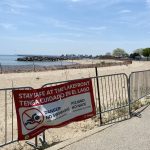The Milwaukee Bike Plan
This month, The Bicycle Federation of Wisconsin and the city of Milwaukee unveiled “Milwaukee by Bike,” the 2010 Bicycle Master Plan, which would guide the development of new bike policies and infrastructure in the city over the next decade. The proposed plan would add over 300 miles of lanes, boulevards and paths for the cyclists, greatly improving the metro area’s existing facilities and expanding resources for cycling in areas where there are little to no facilities in place already.
I talked to Kevin Luecke, the Bike Fed’s lead planner and also the author of the 2010 Milwaukee Bike Plan about some of the specifics and what this means for Milwaukee.
The Milwaukee Bike Plan proposes nearly tripling the amount of on-street bicycle infrastructure in the city. The total miles of facilities proposed by the plan currently are:
Existing Proposed Total
Bike Boulevards 0.00 54.07 54.07
Bike Routes 65.45 9.11 74.56
Bike Lanes 52.47 138.55 191.02
Raised Bike Lanes 0.00 4.82 4.82
Total 117.92 206.55 324.47
What this means is that people will have a far greater network of facilities specifically designed for bicycles available to them. The bicycle network will be much better connected than it currently is and will serve a greater portion of the population. Currently 45 percent of the city’s area is within 1/4 mile of an on-street bicycle facility; when the plan is fully implemented, this figure will rise to 75 percent.
Which areas of Milwaukee will be the most improved?
New bicycle facilities are planned throughout the city. Bicycle lanes obviously require streets that are wide enough to add additional lanes to, so they are limited in certain areas of the city. However, an effort was made during the planning process to designate bicycle boulevards in many of the areas that are under-served by bike lanes.
There are also some questions about the definitions of some of the changes — like what are “bicycle boulevards” ?
These are quiet, traffic-calmed streets that parallel major streets or connect parks, schools, business districts, or other key destinations. By providing traffic calming on these streets, the city can provide a facility that has little motor vehicle traffic. This is beneficial for cyclists who are not comfortable riding with traffic, but also for residents on these streets who will have a safer, more pleasant street to live on.
Additionally, the plan proposes pilot testing raised bicycle lanes in Milwaukee. These are the same as a regular bike lane, except that the lane is raised a few inches from vehicle travel lanes. The two lanes have a gently sloped curb between them, which provides tactile feedback to drivers that they are entering the bike lane, while also allowing people on bicycles to easily enter or leave the lane at any point. If the pilot facilities are successful, more will be implemented in the future.
Also, Dave Schlabowske, the city’s bicycle & pedestrian coordinator, has detailed information about bike boulevards and raised lanes on his personal blog.
The Bike Fed works year-round to educate individuals about the benefits of cycling, and to encourage more people to commute by bike. What are some outreach efforts that are included in the plan?
Education and outreach are key components to making Milwaukee a better place to bike. The plan specifically recommends that the city do some targeted marketing work to reach out to people who may want to bike more, but need a little help to take that next step. Programs such at SmartTrips in Portland and the Twin Cities area have been highly successful in increasing bicycling and reducing driving by reaching out to very specific markets.
The plan also recommends increasing the bicycle education available to children in Milwaukee. Currently, the Bike Fed provides bicycle education to approximately 1,500 Milwaukee youth a year, but this is only a small fraction of all children in the city. The plan calls for providing such education to all elementary school students, likely while they are in fifth grade.
How has the public responded?
The public has been very receptive of the plan. People want options in how they travel and the recreation options available to them, and the bike plan increases those options. Currently it is difficult for many Milwaukee residents to use a bicycle as a safe and efficient form of transportation; this plan seeks to change that and ensure that people who want to bike places can easily do so.
Lastly — and there is always the question of cost — how much will these improvements cost, over what period of time, and where will the money come from?
The costs listed in the plan are slightly over $8,000,000 right now. However, many of the maintenance costs included in this total are operations that the city already performs and will continue to do so. The plan will ideally be implemented over the next five to ten years, putting the annual cost at approximately $1,000,000 per year on average.
To put this in perspective, the city currently spends approximately $70,000,000 each year on streets.
Relative to other transportation projects, what the bike plan proposes provides a very good bang for the city’s buck. The Zoo Interchange currently serves approximately 350,000 trips per day; rebuilding this interchange will cost at least $2.3 billion. According to the plan, approximately 81,000 bike trips are made in the city every day right now, and the entire plan can be implemented for under $10 million. The Zoo serves approximately 4.3 times more trips per day, but will cost more than 230 times more to rebuild than implementing this plan will cost! Building bicycle infrastructure is a cost-conscious, efficient way to use the city’s dollars.
As with all transportation projects, the city will seek out state and federal grants for any of the plan’s projects that may be eligible for them. Extensive funds are available from both the state and the feds for many of these projects. Additionally, the budget for bicycle-related projects will be evaluated every year, as all city budgets are, to ensure that it is a cost effective use of taxpayer dollars.
The full plan is available on the Bike Fed’s website and will remain on view until July 31. The public may comment on the plan until that time, via email or by writing to:
Bicycle Federation of Wisconsin
ATTN: Milwaukee Bike Plan
106 East Doty Street, Suite 400
Madison, WI 53703



















Maybe it’ me, but I still see nothing proposed for the Bayview to Milwaukee connection. Easily the most traveled on and neglected part of the current Milwaukee bike plan.
Hey Tom — from the maps, it looks like there are several longer bike paths dedicated to connecting Bay View to the Third Ward, but they don’t seem to go straight through — most cut off in Walker’s Point.
But you can comment on the plans until the end of the month — make sure to ask the Bike Fed about this! I’m sure everyone would appreciate a MKE-Bay View connection, myself included.
There are some pretty substantial obstacles – three rivers, a harbor, railroad tracks and brownfields – between downtown and Bayview, so bike routing will have to remain to the west on 1st, 2nd and 6th Streets. However, with plans moving forward to re-deck the Hoan bridge, there’s a chance the project can incorporate separate bike lanes, so keep an eye on that and be sure your elected officials know your views.
Low cost, high return. An easy small win for Milwaukee!